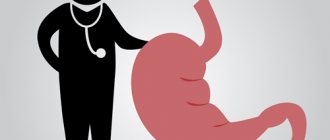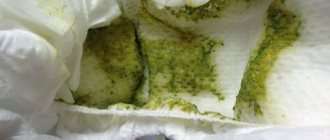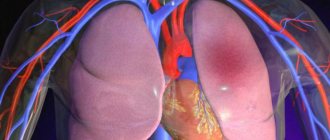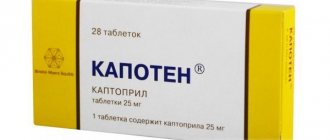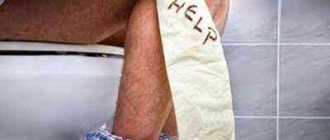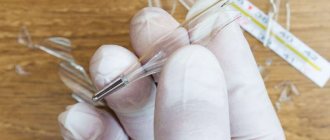From this article you will learn: what is indirect cardiac massage, why, to whom and who can do it. Is it possible to harm a person by performing this procedure, and how to make it really help.
Author of the article: Nivelichuk Taras, head of the department of anesthesiology and intensive care, work experience 8 years. Higher education in the specialty “General Medicine”.
Article publication date: 02/08/2017
Article updated date: 02/05/2020
Indirect cardiac massage is an emergency resuscitation measure aimed at replacing and restoring stopped cardiac activity.
This procedure is the most important for saving the life of a person whose heart has stopped and is in a state of clinical death. Therefore, every person must be able to do cardiac massage. Even if you are not a specialist, but you at least know approximately how this procedure should take place, do not be afraid to do it.
You will not harm the patient if you do something not quite right, and if you do nothing, it will lead to his death. The main thing is to make sure that there are really no heartbeats. Otherwise, even a perfectly performed massage will cause harm.
The essence and meaning of basic cardiopulmonary resuscitation measures
The main task of cardiac massage is to artificially replace myocardial contractions in cases where they have been stopped.
This can be achieved in two ways:
- performing chest compressions by non-specialists, rescuers or emergency medical personnel;
- manual manipulation by a cardiac surgeon directly on the heart during surgery.
Massage manipulations are aimed at maintaining blood circulation through large vessels of the brain, lungs and myocardium. The correct frequency and depth of indirect impact on the heart through the chest wall can provide a 60% release of blood volume compared to the blood flow that occurs with self-contracting myocardium.
Pressure imitates contraction of the heart muscle (systole), and its cessation during complete weakening of the chest - relaxation (diastole).
Hand pressure on the sternum (1), apparatus for indirect cardiac massage (2), internal cardiac massage (3)
The basic complex of resuscitation measures also includes ensuring airway patency and performing artificial pulmonary ventilation (ALV). Their main goal is to maintain gas exchange through forced air renewal.
On a note. It has been established that the main factor in the success of resuscitation is adequate actions during chest compressions. If you are afraid or disdainful to perform artificial respiration, then be sure to give the victim chest compressions, according to the rules described below.
Kinds
What is the difference between these two types of cardiac massage that can help resuscitate a patient in cardiac arrest?
Indirect massage can be performed by anyone with a minimum of knowledge to save the victim and provide emergency care while waiting for medical workers. It is called that because there is no direct contact with the heart; it is influenced from the outside through the chest.
An effective procedure helps the myocardium release about 60% of the blood it itself throws into the blood vessels, which makes it possible to fill the vessels with blood fluid and deliver it to vital tissues and organs, for example, to the brain or lungs. NMS helps restore cardiac activity.
Direct massage is performed only by a doctor on the patient’s open heart. During the procedure, the heart is gently squeezed by hand through an incision in the chest or abdomen. PMS is not a simple emergency intervention and requires certain skills and qualifications of a physician.
Conditions under which external cardiac massage can be performed
Indications for chest compressions are the cessation of heartbeats - the onset of clinical death, recognized by the following signs:
- persistent loss of consciousness;
- lack of pulse;
- respiratory arrest;
- huge pupils that do not react to light.
In case of pain in the heart and/or other symptoms observed in cardiovascular diseases, for example, slowing of inhalations and exhalations, indirect massage and mechanical ventilation are prohibited.
Attention. Artificial massage for the heart “for future use” can result either in stopping its work, or in a significant deterioration in the condition of the sick person.
In what cases is it used and what is it aimed at?
Indirect cardiac massage (also external or closed) in medicine is called a resuscitation measure, the purpose of which is to maintain blood circulation.
The principle of the procedure is that rhythmic compression of the organ imitates its natural functioning and helps restore cardiac activity.
Expert opinion
Tarasov Dmitry Timofeevich
Master of Sports in mountaineering. Author of scientific articles on the topic of survival in the wild
Problems with blood circulation can be caused by congenital and acquired diseases, overdose of drugs or medications, road accidents, electric shock, etc.
The indication for the beginning of the body's revival is clinical death - the process of dying, which is characterized by the absence of external signs of life, while metabolism in tissues and brain function are still preserved.
The transition period lasts up to ten minutes after the heart stops, then the brain is destroyed and restoration of vital functions becomes impossible.
How to determine whether a person has reached clinical death or whether it has already entered the biological stage?
| Clinical death | Biological death |
|
|
The main reason for resuscitation is always complete cardiac arrest. The rescuer must make sure that there is no heartbeat and only then begin to revive the body. Also, a prerequisite for the procedure is a constant assessment of the condition of the person being resuscitated.
The effectiveness of the procedure is assessed by the body returning to normal.
- feel the pulse (the pulse is considered stable if it does not stop for several minutes);
- blood pressure increases;
- pupils move (constriction);
- skin tone normalizes;
- the ability to breathe will be restored.
How to start the indirect myocardial massage procedure
Checking for breathing using vision, hearing and tactile sensation on the skin of the cheek
Before we talk directly about the technique of heart massage itself, we will pay attention to the preparatory actions, which will simultaneously serve as permission to perform it:
- Quickly inspect the scene to avoid getting into a similar situation yourself, for example, getting an electric shock from a bare wire.
- Check the victim's consciousness. It is forbidden to shake him violently, hit him on the cheeks, pour water on him, let him sniff ammonia or ammonia, or waste time looking for and applying a mirror to his lips. Firmly squeeze the person who you think is lifeless by the arm or leg, carefully jog and call out to him loudly.
- If there is no reaction, make sure the victim is lying on a hard, level surface and turn him onto his back. If there is no need, then do not move or carry a person in trouble anywhere.
- Open the victim’s mouth slightly and tilt your ear towards him so that you can see his chest from the side and above; if you can, then try to feel the pulse where you can and know how. For 10 seconds, examine your breathing using the “SOS – listen, feel, see” method (see photo above). Here's what it is:
- C – listen with your ear for sounds of inhalation and exhalation;
- O – try to feel the presence of exhalation with your cheek;
- C – look at the chest, whether it moves or not.
Why is the need for cardiac massage primarily determined by the absence of respiratory cycles, and not by cardiac arrest?
The algorithm for providing assistance begins not with palpating the pulse, but with listening to breathing
- Firstly , it is difficult for ordinary people to quickly feel a “healthy” pulse on the wrist even in normal situations, let alone in extreme conditions, in which, in addition to weak beating and/or too infrequent beats, it is recommended to palpate the heart rate on the carotid artery.
- Secondly , a frightened person may be afraid to open the victim’s eyes to determine the size of the pupils, moisture and transparency of the cornea, or may not be able to correctly assess these characteristics.
- Thirdly , because loss of breathing quite quickly ends in cardiac arrest and loss of consciousness. If there is no breathing, the main thing is to ensure access of blood to the brain and prevent its cortex from dying.
Indirect cardiac massage technique
European Resuscitation Council guidelines for non-specialists - the CAB algorithm
At present, not for doctors or rescuers, but for ordinary people who, due to current circumstances, are forced to provide assistance to start the heart and restore respiratory cycles, the following procedure is recommended:
- C (circulacion) – performing a cycle of external cardiac massage;
- A (airwey) – control and ensure free passage of air into the lungs;
- B (breathe) – artificial ventilation of the lungs.
How to do indirect cardiac massage correctly
Correct technique of closed cardiac massage for a victim over 8 years of age
Today it is recommended to adhere to the following rules for performing external cardiac massage:
- The position of the hands of the person providing assistance should be perpendicular to the victim’s chest, and he himself should be on the side of it.
- The palms should be folded one on top of the other, and the fingers should be raised, or the fingers should be interlocked.
- In order not to injure the lower extremity of the sternum - the xiphoid process, the base of the “lower” palm should be rested in its middle.
- The frequency of compressions during chest compressions is the optimal rate for an adult from 100 to 120 compressions per second.
- When doing presses, do not bend your elbows! The pressure occurs due to the weight of the body during its tilt.
- The number of massage pressures in one continuous cycle is 30 times.
- The pressure should be such that the palms “sink down” by 5-6 cm.
On a note. It is imperative to ensure that the ratio of the time of pressing and the time of returning the hands to the starting position is the same. This is extremely important for filling the heart chambers with a sufficient volume of blood.
Ensuring access of air to the lungs and artificial ventilation of the lungs
Since cardiac massage only provides blood movement and cannot prevent hypoxia of the tissues of the cerebral cortex, massage should be combined with mechanical ventilation to ensure gas exchange.
Safar's triple move
Before starting artificial respiration, it is necessary to facilitate free access of air into the lungs.
First, place the victim’s head in a position that prevents the tongue from retracting (see picture above):
- tilt your head back - at the same time press on your forehead with one hand and lift your neck with the other (1);
- push the lower jaw forward - pick up the lower jaw with your fingers and align the lower and upper teeth in one plane (2);
- open your mouth, pulling your chin down a little (3);
- Check the position of the tongue, and if it is stuck, pull it out with two fingers.
Then check the position of the tongue and the presence of mucus. If necessary, the tongue is pulled out with 2 fingers, like tongs, and the mucus is collected with the index finger, acting like a spatula.
Important. If a neck fracture is suspected, the head is not thrown back, and when performing artificial inhalation, in order not to further move the vertebrae, they try not to put strong pressure on the mouth.
Mechanical ventilation techniques and rules
If, after the first 30 rhythmic pressures on the middle of the sternum and restoration of airway patency, cardiac activity has not resumed, alternating mechanical ventilation with the mouth-to-mouth technique and IMS begins:
- Take a deep breath yourself, pinching the victim’s nose with two fingers.
- Within 1 second, exhale your air completely into his mouth. At this time, squint your eyes and look at the chest to see if it has expanded or not.
- Pause for 2-4 seconds. It will simulate passive exhalation.
- Repeat the exhalation into your mouth for a second, controlling the movements of your chest.
- Straighten up and begin doing 30 presses to the middle of the chest.
The optimal relationship between cardiac massage and passive breathing
Number of artificial breaths
There is no need to make more than 2 exhalations into the victim’s mouth. Their excess quantity increases tidal volume, which leads to a decrease in cardiac output and blood circulation.
Artificial respiration techniques
The “mouth to mouth” method is replaced by “mouth to nose” if a person has an injury to his mouth or is unable to open it. In this case, you need to monitor the tightness of the ventilator, supporting your chin with your fingers just in case.
Reasons for the ineffectiveness of mechanical ventilation
If the chest does not inflate during the first artificial breaths, this may result in:
- insufficient sealing of the respiratory tract - the nose (or mouth) is not tightly closed;
- weak exhalation force of the person providing assistance;
- the presence of mucus or foreign objects in the victim’s mouth.
What to do in the first two cases is clear, but when trying to remove a foreign object using your thumb and forefinger, act extremely carefully so as not to push it even deeper.
Heart - main functions and consequences of its stopping
The heart is not only the “motor” of the body, but also a kind of “pump” consisting of four chambers - 2 atria and 2 ventricles. Due to its ability to contract and relax, blood circulation throughout the body occurs.
Together with the blood flow, all organs and tissues of the body are supplied with oxygen and nutrients, without which they die. In addition, the blood absorbs waste products of its vital activity, which then enter the kidneys, lungs and skin and are eliminated from the body.
When the heart stops, blood circulation stops, and the supply of vital substances to all organs, as well as oxygen, stops, without which cells begin to rapidly die. In addition, carbon dioxide and other waste products of organs cease to be removed from the body, which provokes poisoning of the body.
For example, brain cells begin to die within 3-4 minutes from the onset of cardiac arrest. Of course, there are exceptions, but these are only isolated cases.
In general, the maximum amount of time allotted for starting the heart, so that irreversible consequences do not appear, is only 7 minutes.
Features of cardiopulmonary resuscitation in children
Differences in techniques for performing IMS and mechanical ventilation in infants and young children from adults
To help children, you should remember a few simple and easy to remember rules:
- The algorithm for performing cardiopulmonary resuscitation, the pace and frequency of pressing during chest compressions for all age categories, starting from birth, is the same, as is its ratio with mechanical ventilation - 30 to 2.
- For an infant, throwing back the head should be easy. Strong neck deflection in infants leads to airway obstruction!
- For a child aged 1 to 10 years, pressing on the middle of the sternum is carried out with only one hand. In newborns and infants, indirect heart massage is performed with bundles of 2 (middle and ring) or 3 (+ index) fingers.
- Air is blown into the infant's mouth and nose at the same time. This technique is also recommended for use in older children, as long as the size of the facial skull allows such a girth to be made without violating its tightness.
- Be careful! The force, depth and volume of air during passive inspiration should not be large, especially if mechanical ventilation is performed on an infant. Conventionally, the volume should be equal to the amount of air that fits “between your cheeks,” taken without a deep breath, and the exhalation should be like a blow.
On a note. The recommended force (depth) of pressure in children and newborns is approximately 1/3 of the chest diameter. There is no need to be afraid of breaking bones. At this age, they are still pliable and have not completely ossified.
When you can and should call for help
It is absolutely impossible to delay starting external cardiac massage, but when can you be distracted by calls for help and calling an ambulance?
| Presence of people and age of the unconscious person | Procedure |
| Call loudly and briefly to those you see. Do this without stopping pressing on the sternum. After their arrival, quickly ask to call an ambulance, continuing resuscitation efforts. After the call, they can help, for example, you continue to do mechanical ventilation, and they, alternating with each other, do IMS. |
| After performing “SOS”, first call an ambulance. Otherwise, all your efforts to maintain blood flow in the cerebral cortex may be pointless if professional medical assistance is not provided in a timely manner. | |
| No calls! First of all, do 4-5 cycles of IMS + ventilation. And only after that, stop to call an ambulance. |
Forecast
The prognosis for cardiac resuscitation depends on the possibility of resuming brain function. A preliminary assessment can be made based on the time taken to resume breathing and heartbeat, the degree of dysfunction of internal organs (kidneys, liver, heart, fundus, central nervous system), heart rate and other vital signs.
An unfavorable prognosis is considered in the presence of severe organic disease, developmental defects, multiple organ failure, large blood loss, disseminated intravascular coagulation syndrome, and a history of repeated cardiac arrests. It also worsens when complications of closed massage occur.
Thus, to perform cardiac massage, it is necessary to be able to recognize emergency situations that require its rapid initiation. The effectiveness of the measures taken depends on compliance with all rules and recommendations, knowledge and skills of the rescuer.
